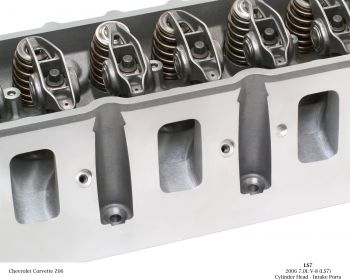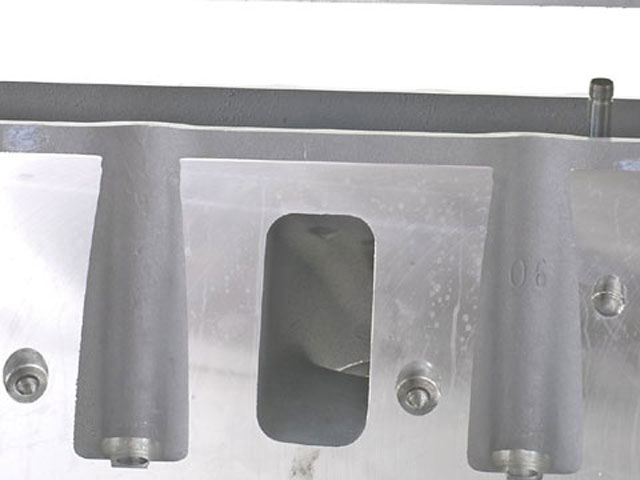LS1 Head
|
A LS1 Head refers to the original design of the GEN III cylinder head produced from General Motors. The design relates to LS2, LS3, LS6, and LS7 heads. It can also include non Corvette heads LQ4/LQ9, and L92 designs. Confused yet? Well relax, we will help you figure out the differences!
Every V8 Engine that GM produces for cars and trucks uses one of these designs. Each one has a specific use for performance, durability, cost, warranty claims etc. What they change is Combustion Chamber size/shape, intake/exhaust port design, Int/Exh size and valve material, with valve springs that are designed to handle different cams and profiles. |
LS7 Head (Rectangular port)

Cylinder Heads – Port Design
Cylinder head interchangeability enables great parts mixing to build custom LS engine combinations, but the heads must be matched with intake manifolds that have compatible intake port configurations. The port sizes and shapes include:
Rectangular port – LS7-style – The second LS intake runner design debuted on the Corvette Z06’s LS7 engine. This rectangular design supports the straight-through airflow design of the heads. They feature 270cc intake ports and the ports and combustion chambers are CNC-ported from the factory. Use only with the LS7 intake manifold.
Ported LS6 Head (Cathedral port)

Cathedral port – Introduced on the LS1 engine and used also on the LS6 and LS2, cathedral-port heads are named for the unique shape of the top of the intake port. Intake manifolds for LS1, LS2, LS6 and Vortec engines with cathedral-port heads are mostly interchangeable. They do not come with any sort of porting from the factory.
LS3 L92 Non Ported Intake (Rectangular port)

Rectangular port – L92 style – Similar to the LS7 design, but the ports are a little taller and a little narrower. They flow more than cathedral-port heads, but not as much as LS7 heads. In addition to the L92 6.2L engines, this port shape is also used on LS3 engines and some 6.0L truck engines, as well as the Corvette ZR1’s LS9 and Cadillac CTS-V’s LSA supercharged engines. Intake manifold bolt patterns are unique to this port design. They do not come with any sort of porting from the factory.
C5R heads – These heads pioneered the rectangular-port design, but because they are designed for professional finishing, their final shape and size depends on whoever is performing the porting.
Head-to-Block Compatibility
| Because of their comparatively small bores – 3.89 inches – LS1 and LS6 engines can only use LS1, LS6 and LS2 heads. Using heads designed for larger engines will cause valve-to-block interference. The larger, 4.00-inch bore of the LS2 enables it to use LS1/LS6 heads, as well as L92-style heads (including LS3, LS9 and LSA engines). The 6.2L engines (LS3, L92, etc.) can use any head except for the LS7 and C5R, while the 7.0L LS7 and C5R blocks can use any LS-series head. LS7 blocks should be matched with heads designed for at least 4.10-inch bores; and 4.125-inch bores are preferred. |
Most LS production cylinder blocks share the came cylinder head bolt pattern and the same size head bolts – four 11mm bolts per cylinder (10 in total) and five upper, 8mm bolts. Early LS1 and LS6 engines used different-length 11mm bolts, but engines from 2004 and later use same-length bolts. LS9 engines use stronger, 12mm head bolts.
Non-production blocks, such as GM Performance Parts’ LSX block and the C5R, offer the same head-bolt pattern as production blocks. All LS heads will bolt up to them, but care must be taken to select the most compatible heads based on the appropriate bore size. Because of their large bores, heads designed for at least 4.10-inch bores should be used and 4.125-inch bores are preferred, such as the L92/LS3 or LS7 heads; otherwise valve-to-block interference is an issue, as is sufficient cylinder sealing.
GM Performance Parts’ new LSX cylinder heads use 10 11mm and 13 8mm head bolts, or eight more than a regular-production LS head. That’s more than 50 percent more head bolts than production heads, supplying superior clamping strength.
LS3 Head Removal Video
GM Head Guide
Casting Number 241
Head: 1997+ LS1 5.7 Litre Passenger Car
Material: Aluminimum
Part Number:
12558806 (1997‑98)
12559853 (1999‑00)
12564241 (2001‑03)
Combustion Chamber Volume: 66.67cc
Compression Ratio: 10.1:1
Intake Port Volume: 200cc
Exhaust Port Volume: 70cc
Intake Valve Diameter: 2.00 inches
Exhaust Valve Diameter: 1.55 inches
Casting Number 243
Head: 2001 LS6 5.7 Litre Passenger Car
Material: Aluminimum
Part Number:
12564243
Combustion Chamber Volume: 64.45cc
Compression Ratio: 10.5:1
Intake Port Volume: 210cc
Exhaust Port Volume: 75cc
Intake Valve Diameter: 2.00 inches
Exhaust Valve Diameter: 1.55 inches
Casting Number 706
Head: 1999+ LR4 4.8 Litre Truck
1999+ LM4 /LM7 5.3 Litre Truck
Material: Aluminimum
Part Number:
12559852
12561706
Combustion Chamber Volume: 61.15cc
Compression Ratio: 9.5:1
Intake Port Volume: 200cc
Exhaust Port Volume: 70cc
Intake Valve Diameter: 1.89 inches
Exhaust Valve Diameter: 1.55 inches
Casting Number 373
Head: 1999‑2000 LQ4 6.0 Litre Truck
Material: Cast Iron
Part Number:
12561873
Combustion Chamber Volume: 71.06cc
Compression Ratio: 9.5:1
Intake Port Volume: 210cc
Exhaust Port Volume: 75cc
Intake Valve Diameter: 2.00 inches
Exhaust Valve Diameter: 1.55 inches
Casting Number 317
Head: 2001+ LQ4 6.0 Litre Truck
Material: Aluminimum
Part Number:
12572035
Combustion Chamber Volume: 71.06cc
Compression Ratio: 10:1
Intake Port Volume: 210cc
Exhaust Port Volume: 75cc
Intake Valve Diameter: 2.00 inches
Exhaust Valve Diameter: 1.55 inches
Head: GMPP C5R
Material: Aluminimum
Part Number:
12480005
Combustion Chamber Volume: 38cc
Compression Ratio:
Intake Port Volume:
Exhaust Port Volume: 70cc
Head: GMPP C5R
Material: Aluminimum
Part Number:
12480025
Combustion Chamber Volume: 38cc
Compression Ratio:
Intake Port Volume:
Exhaust Port Volume: 70cc
Head: GMPP C5R
Material: Aluminimum
Part Number:
12480090
Combustion Chamber Volume: <30cc
Compression Ratio:
Intake Port Volume:
Exhaust Port Volume: 70cc
Click here to go back to the home page from LS1 Head
 Chris Trautman @ Corvette Assembly Plant 2019
Chris Trautman @ Corvette Assembly Plant 2019About Us: Corvette Web Central | Owner Bio: Chris Trautman
Established in 2008 by Chris Trautman, Corvette Web Central quickly grew into one of the top leading Corvette enthusiast websites globally.
"This website is a passion of mine, just as much as being a Corvette owner," says Chris. He was frustrated trying to find information on the internet about Corvettes which was was not biased or influenced somehow.
He has owned three Corvettes over the last twenty years and does not plan to stop owning one anytime soon.
Note: Some links on this page are part of our affiliate program and provide a small portion of proceeds to fund the administrative costs and to fund more product reviews. We are not paid to perform the reviews or are we given any products for free.



New! Comments
Have your say about what you just read! Leave me a comment in the box below.